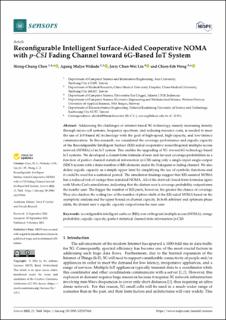| dc.description.abstract | Addressing the challenges of internet-based 5G technology, namely increasing density through micro-cell systems, frequency spectrum, and reducing resource costs, is needed to meet the use of IoT-based 6G technology with the goal of high-speed, high-capacity, and low-latency communication. In this research, we considered the coverage performance and ergodic capacity of the Reconfigurable Intelligent Surface (RIS)-aided cooperative nonorthogonal multiple-access network (NOMA) of an IoT system. This enables the upgrading of 5G- toward 6G-technology-based IoT systems. We developed a closest-form formula of near and far user coverage probabilities as a function of perfect channel statistical information (p-CSI) using only a single-input single-output (SISO) system with a finite number of RIS elements under the Nakagami-m fading channel. We also define ergodic capacity as a simple upper limit by simplifying the use of symbolic functions and it could be used for a sustained period. The simulation findings suggest that RIS-assisted NOMA has a reduced risk of outage than standard NOMA. All of the derived closed-form formulas agree with Monte Carlo simulations, indicating that the distant user’s coverage probability outperforms the nearby user. The bigger the number of RIS parts, however, the greater the chance of coverage. They also disclose the scaling law of the number of phase shifts at the RIS-aided NOMA based on the asymptotic analysis and the upper bound on channel capacity. In both arbitrary and optimum phase shifts, the distant user’s ergodic capacity outperforms the near user.
Keywords: reconfigurable intelligent surfaces (RIS); non-orthogonal multiple access (NOMA); outage probability; ergodic capacity; perfect statistical channel state information (p-CSI) | en_US |

